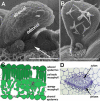Shoot meristem function and leaf polarity: the role of class III HD-ZIP genes
- PMID: 16846251
- PMCID: PMC1484593
- DOI: 10.1371/journal.pgen.0020089
Shoot meristem function and leaf polarity: the role of class III HD-ZIP genes
Abstract
The shoot apical meristem comprises an organized cluster of cells with a central region population of self-maintaining stem cells providing peripheral region cells that are recruited to form differentiated lateral organs. Leaves, the principal lateral organ of the shoot, develop as polar structures typically with distinct dorsoventrality. Interdependent interactions between the meristem and developing leaf provide essential cues that serve both to maintain the meristem and to pattern dorsoventrality in the initiating leaf. A key component of both processes are the class III HD-ZIP genes. Current findings are defining the developmental role of members of this family and are identifying multiple mechanisms controlling expression of these genes.
Conflict of interest statement
Competing interests. The author has declared that no competing interests exist.
Figures



Similar articles
-
ALTERED MERISTEM PROGRAM1 Restricts Shoot Meristem Proliferation and Regeneration by Limiting HD-ZIP III-Mediated Expression of RAP2.6L.Plant Physiol. 2018 Aug;177(4):1580-1594. doi: 10.1104/pp.18.00252. Epub 2018 Jun 8. Plant Physiol. 2018. PMID: 29884678 Free PMC article.
-
Molecular Mechanisms of Leaf Morphogenesis.Mol Plant. 2018 Sep 10;11(9):1117-1134. doi: 10.1016/j.molp.2018.06.006. Epub 2018 Jun 28. Mol Plant. 2018. PMID: 29960106 Review.
-
KANADI and class III HD-Zip gene families regulate embryo patterning and modulate auxin flow during embryogenesis in Arabidopsis.Plant Cell. 2007 Feb;19(2):495-508. doi: 10.1105/tpc.106.047472. Epub 2007 Feb 16. Plant Cell. 2007. PMID: 17307928 Free PMC article.
-
Active suppression of a leaf meristem orchestrates determinate leaf growth.Elife. 2016 Oct 6;5:e15023. doi: 10.7554/eLife.15023. Elife. 2016. PMID: 27710768 Free PMC article.
-
Interplay of HD-Zip II and III transcription factors in auxin-regulated plant development.J Exp Bot. 2015 Aug;66(16):5043-53. doi: 10.1093/jxb/erv174. Epub 2015 Apr 23. J Exp Bot. 2015. PMID: 25911742 Review.
Cited by
-
Illuminating the molecular mechanisms underlying shoot apical meristem homeostasis in plants.Plant Biotechnol (Tokyo). 2022 Mar 25;39(1):19-28. doi: 10.5511/plantbiotechnology.22.0213a. Plant Biotechnol (Tokyo). 2022. PMID: 35800970 Free PMC article.
-
Identification and profiling of narrow-leafed lupin (Lupinus angustifolius) microRNAs during seed development.BMC Genomics. 2019 Feb 14;20(1):135. doi: 10.1186/s12864-019-5521-8. BMC Genomics. 2019. PMID: 30764773 Free PMC article.
-
HD-ZIP III activity is modulated by competitive inhibitors via a feedback loop in Arabidopsis shoot apical meristem development.Plant Cell. 2008 Apr;20(4):920-33. doi: 10.1105/tpc.107.057448. Epub 2008 Apr 11. Plant Cell. 2008. PMID: 18408069 Free PMC article.
-
Quantitative control of ASYMMETRIC LEAVES2 expression is critical for leaf axial patterning in Arabidopsis.J Exp Bot. 2013 Nov;64(16):4895-905. doi: 10.1093/jxb/ert278. Epub 2013 Sep 4. J Exp Bot. 2013. PMID: 24006428 Free PMC article.
-
Predicting yield of individual field-grown rapeseed plants from rosette-stage leaf gene expression.PLoS Comput Biol. 2023 May 30;19(5):e1011161. doi: 10.1371/journal.pcbi.1011161. eCollection 2023 May. PLoS Comput Biol. 2023. PMID: 37253069 Free PMC article.
References
-
- Sussex IM. Morphogenesis in Solanum tuberosum L.: Experimental investigation of leaf dorsiventrality and orientation in the juvenile shoot. Phytomorph. 1955;5:286–300.
-
- Snow M, Snow R. The dorsiventrality of leaf primordia. New Phytol. 1959;58:188–207.
-
- Reinhardt D, Frenz M, Mandel T, Kuhlemeier C. Microsurgical and laser ablation analysis of leaf positioning and dorsoventral patterning in tomato. Development. 2005;132:15–26. - PubMed
-
- Waites R, Hudson A. phantastica: A gene required for dorsoventrality of leaves in Antirrhinum majus . Development. 1995;121:2143–2154.
-
- Waites R, Selvadurai HR, Oliver IR, Hudson A. The PHANTASTICA gene encodes a MYB transcription factor involved in growth and dorsoventrality of lateral organs in Antirrhinum . Cell. 1998;93:779–789. - PubMed
Publication types
MeSH terms
Substances
LinkOut - more resources
Full Text Sources
Other Literature Sources

